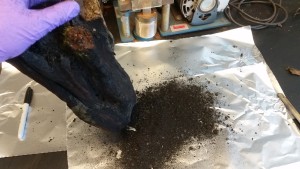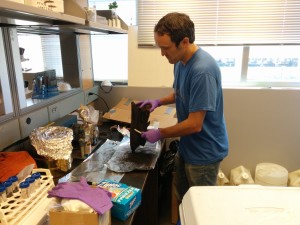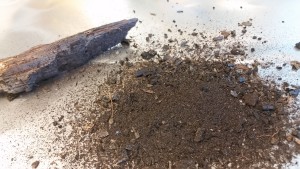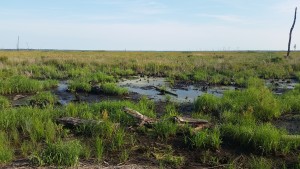We (myself and Patrick Hatcher from ODU) are excited to have recently been awarded funding from the National Science Foundation’s Low Temperature Geochemistry Program in collaboration with the lead PI, Andy Zimmerman from the University of Florida, and co-PI, Siddhartha Mitra from East Carolina University.  The project, titled “Dissolved pyrogenicorganic matter dynamics in the environment,” will examine the fate of incompletely combusted woods and grasses (sometimes referred to as “black carbon” or “biochar” depending on context) over time in the environment. This black carbon is produced naturally from forest fires and anthropogenically in wood stoves or chimneys or when they are produced as biochars for the purpose of applying them to soils to improve soil fertility. Because of its molecular properties, black carbon is thought to be highly recalcitrant and immobile in the environment contributing to carbon sequestration in soils and sediments. Recent work shows that some fraction of black carbon can become soluble and transported to aquatic environments where its impacts are unknown. This project will help us understand how much of black carbon becomes soluble when light and biological organisms transform its molecular structure. The results will have important impacts on our understanding of black carbon cycling in the environment.
The project, titled “Dissolved pyrogenicorganic matter dynamics in the environment,” will examine the fate of incompletely combusted woods and grasses (sometimes referred to as “black carbon” or “biochar” depending on context) over time in the environment. This black carbon is produced naturally from forest fires and anthropogenically in wood stoves or chimneys or when they are produced as biochars for the purpose of applying them to soils to improve soil fertility. Because of its molecular properties, black carbon is thought to be highly recalcitrant and immobile in the environment contributing to carbon sequestration in soils and sediments. Recent work shows that some fraction of black carbon can become soluble and transported to aquatic environments where its impacts are unknown. This project will help us understand how much of black carbon becomes soluble when light and biological organisms transform its molecular structure. The results will have important impacts on our understanding of black carbon cycling in the environment.
We recently (July 2015) collected natural wood chars from the Great Dismal Swamp National Wildlife Refuge (pictured above) in Virginia and North Carolina as part of this project. The wood chars resulted from natural fires in 1976, 2006, and 2011. The charred components were scraped and consolidated in the lab (pictured below), and we will conduct several experiments aimed at understanding their chemical makeup and what processes control how much of the chars dissolve in water. Comparing the chemical characteristics of these chars will allow us to understand how natural biological and photochemical degradation processes change their mobility within the environment. The results from these natural samples will be compared to experiments with laboratory produced biochars and help us understand the impacts of chars in the aquatic environment.







Recent Comments